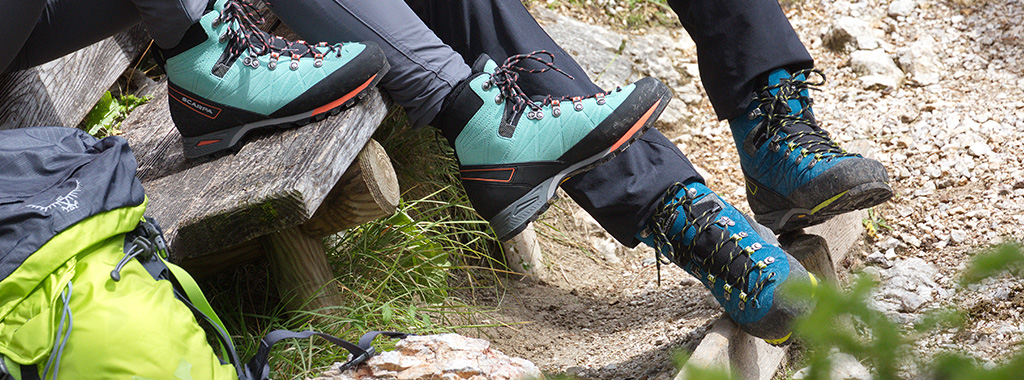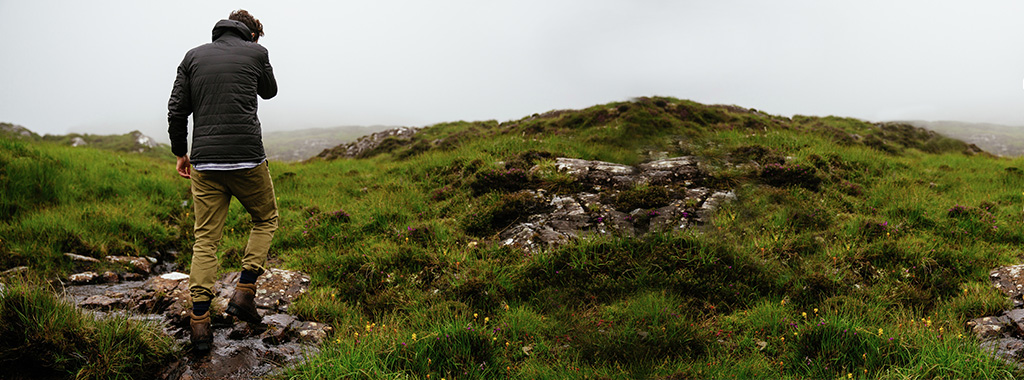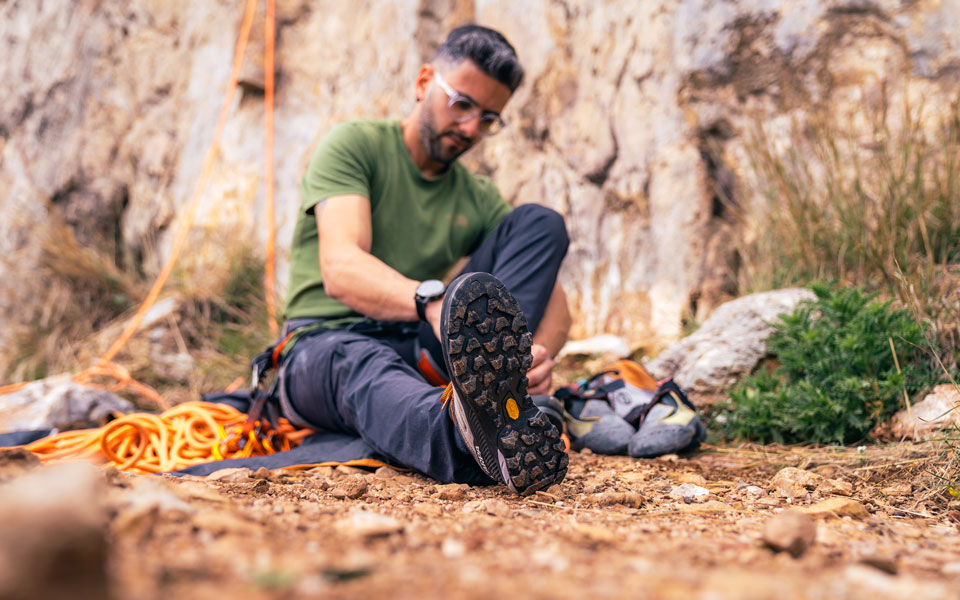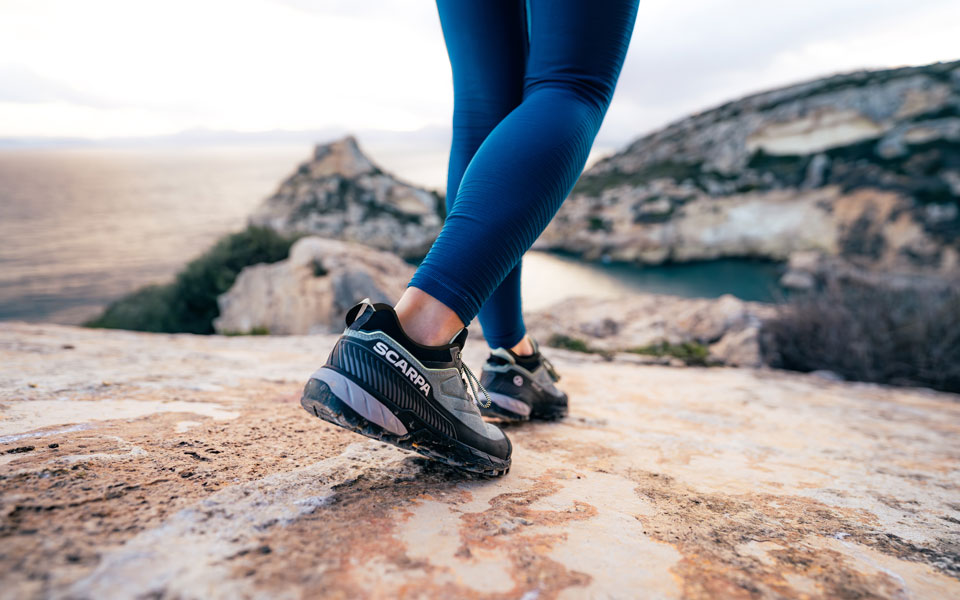Scarpa is an iconic Italian brand that has been handcrafting high-quality hiking and outdoor footwear since 1938. For over 80 years, Scarpa has combined traditional Italian shoemaking techniques with innovative technology to create durable and comfortable boots built for mountain terrain. Scarpa walking boots are crafted in the heart of the Dolomites in Asolo, Italy and draw inspiration from this stunning mountain landscape. The Scarpa family founded the company, initially making leather ski boots. In 1956, Scarpa introduced the first fully rigid telemark boot, revolutionising backcountry skiing. This innovative spirit led the brand into hiking and mountaineering footwear. Scarpa became renowned for making reinforced boots that performed well on steep terrain and rocky alpine routes. While Scarpa utilises advanced technology and testing, each boot still relies on expert Italian craftsmanship. Most boots feature a combination of handcrafting and machine stitching to achieve both precision and durability. Scarpa maintains its founder's mission to make finely constructed footwear that performs superbly in mountain environments. After over 80 years, Scarpa continues to balance its heritage of quality artisanal construction with innovative new designs to meet the needs of modern hikers and backpackers.
Scarpa Hiking Boots Key Features & Technologies
Scarpa incorporates a range of design features into its hiking boots to optimise performance on mountainous trails.
Outsole Materials
The outsoles on Scarpa hiking boots utilise proprietary rubber compounds engineered for optimal traction and durability across rugged alpine environments. Many Scarpa models incorporate high-performance Vibram rubber in their outsole construction. The precise Vibram rubber compounds are formulated to maintain a pliable grip across an array of surfaces from loose scree to wet boulders. The rubber tread geometries are computer-optimised to provide braking control on steep inclines and shed debris on rapid descents. Scarpa also employs their Impact Brake System (IBS) technology on certain outsoles. IBS strategically positions angled lugs to provide uphill and downhill braking power. This improves stability and control when moving with speed and confidence over variable mountainous terrain. The proprietary tread designs and durable Vibram rubber deliver excellent traction over many miles without excessive wear. Robust outsoles ensure a stable platform even when carrying substantial pack weight across rough and uneven land.
Shock-Absorbing Midsoles
Many Scarpa hiking boots feature a bi-density polyurethane midsole which combines a firm density PU for torsional rigidity under the arch with a softer density PU in the heel strike zone for shock absorption. This balances impact damping during foot strikes with stability when leveraging forward off the toe. On lighter models, moulded ethylene-vinyl acetate (EVA) provides a blend of cushioning and energetic rebound thanks to the elastomeric properties of EVA foam. For cold-weather boots, a Pebax Rnew midsole maintains flexibility in freezing temperatures that would make most materials brittle. Dual-density EVA and select polyurethanes deliver an ideal balance underfoot between shock attenuation and propulsion to reduce hike fatigue over endless uneven miles.
Waterproofing
Scarpa integrates both proprietary waterproof membranes and well-known technologies from acclaimed brands to keep feet dry inside their boots. Many models utilise OutDry, a permanently bonded proprietary membrane with billions of microscopic pores that block exterior water molecules while allowing interior water vapour to escape. Scarpa also extensively employs GORE-TEX performance membranes selected based on stringent lab testing to validate they meet the specific wetness protection, breathability and durability demands of the boot's intended activity. The non-porous expanded polytetrafluoroethylene (ePTFE) GORE-TEX membrane prevents external liquid water from entering while allowing sweat vapour to vent. By selectively incorporating only properly vetted waterproof membranes purpose-built for hiking demands, Scarpa delivers water protection without compromising breathability and comfort.
Rigidity and Flexibility
Scarpa rigorously engineers the optimal balance of rigidity and flexibility in each hiking boot model based on its intended activity and use. For stiffer backpacking boots made for carrying heavier loads, Scarpa integrates shaped shanks of various thermoplastics like Pebax or polyurethane. Shank geometries are designed based on pressure analysis to provide stiffness for precision edging and stability under load while allowing natural flexion at key areas underlying the metatarsals. This enables necessary forward propulsion when stepping uphill. In more flexible boots, the shank is positioned further back to allow greater compliance under the ball of the foot. Scarpa also adjusts torsional stiffness and rebound in the midsole based on activity demands. The midsole may incorporate Pebax or ESS frames which add lateral rigidity along the boot length while permitting some longitudinal give for walking comfort. Dual-density midsole constructions provide impact absorption in the heel while maintaining rigidity. Upper materials and lacing systems are also tuned for flexibility or support. Using finite element analysis simulation and lab testing, Scarpa optimises the flex and rigidity balance specific to each boot model's intended hiking performance.
Upper Materials
The upper material selection plays a key role in determining boot weight, breathability, weather protection and durability. For lightweight trekking models, airy mesh fabrics or synthetic blends maximise ventilation. Mid-weight hiking boots may feature abrasion-resistant Cordura nylon or durable TPU-coated textile uppers which offer a sturdy balance of breathability and resilience. Heavy-duty backpacking boots tend to utilise thick, full-grain leathers which provide the requisite abrasion, puncture and tear-resistance for prolonged use hauling packs across rugged terrain. Strategically positioned protective rands, bumpers and rubberised toe caps shield the upper against scuffs and scrapes. The precisely positioned mix of synthetic fabrics, hearty Cordura and dependable leathers enable Scarpa boots to stand up to hardcore usage across endless miles while delivering the ventilation or weatherproofing needed for its designed hiking activity.
Weight-Saving Components
Scarpa utilises advanced manufacturing techniques to minimise boot weight without compromising integrity and durability. Their Peel Tech construction strategically places protective thermoplastic rands only in high-abrasion areas over the toe cap and heel. This results in a 25% reduction in weight versus full perimeter randing. The midsoles feature precision-cut ports and hollows to remove non-critical material. Scarpa also analyses the forces exerted across the boot's surface during hiking to optimise the thickness and location of structural reinforcements so critical components like shanks can be trimmed to barely the necessary minimum thickness required. This precise placement and sparse integration of reinforcing elements reduces weight while enhancing support exactly where needed. Ultra-lightweight yet durable textiles such as breathable mesh and Kevlar fabrics are chosen to produce adequately sturdy uppers at minimal weights. Through extensive lab testing and computer simulation, Scarpa can trim every excess gram by strategically placing only the essential reinforcing and protective components necessary precisely where critical to achieving substantial weight savings.
Weatherproof Membranes
Scarpa selectively incorporates proprietary waterproof/breathable membranes like OutDry or industry-leading technologies like GORE-TEX based on rigorous lab analysis to validate membrane suitability. They precisely match the microporous membrane pore size and breathability rating to the environmental conditions and perspiration demands of each boot model based on its intended activity and expected environmental conditions. A fast-moving trekking shoe may need a membrane tuned for maximum vapour permeability to prevent heat buildup and sweat accumulation inside the boot during high aerobic output. A cold-weather mountaineering boot demands a membrane with smaller pores to restrain convection for insulation even if somewhat compromises breathability. Rigorous lab testing informs the ideal pairings between membrane technology, pore size, and placement to enable the optimal balance of weather protection and breathable comfort for the conditions the boot is designed and engineered to operate within.
Antimicrobial Sock Liners
The plush sock liners inside Scarpa’s hiking boots utilise advanced textile treatments to eliminate odour-causing bacteria. The moulded EVA and memory foam liners incorporate Microban antimicrobial technology. Microban additives infused into the liner materials during manufacturing contain built-in antimicrobial agents that continually kill and suppress the growth of bacteria, mould and mildew. This prevents the accumulation of microbes that lead to foot odour even after months of wear without washing. The Microban agents retain their bactericidal properties for the lifetime of the liner. When combined with moisture-wicking fabrics engineered to rapidly dissipate sweat, the antimicrobial sock liners keep feet feeling fresh and healthy during extended use. The long-term anti-odour treatments enhance boot hygiene and comfort when spending consecutive days logging miles deep in the backcountry far from laundry facilities.
Fit and Lacing Technologies
Scarpa meticulously engineers its hiking boots to achieve a secure and precise fit with minimal break-in required. They craft boots on gender-specific lasts sized using 3D scanning data and pressure analysis to ensure correct anatomical contours. Many models employ lacing systems like Scarpa's Prolace design which threads a single durable lace through floating polymer eyelets that uniformly cinch the boot close around the foot. This adjustable system tunes fit across the ankle, instep, and forefoot for a truly customised and dialled-in fit. An integrated harness wraps the heel to prevent lift while an abrasion-resistant gusseted tongue connected to the upper seals out debris. Optional heel tensioning devices fine-tune heel lockdown to prevent slippage on inclines. Carefully crafted footbeds provide under-arch support. Some winter boots feature heat-moldable linings that contour to the exact shape of the foot for a custom-tailored interior. With precision construction techniques and innovative lacing systems, Scarpa achieves a performance-oriented fit engineered for security, comfort and control - allowing you to charge ahead across uneven terrain with confidence in each step.
Technologies Engineered for Scarpa Trekking and Backpacking Boots
Scarpa equips their trekking and backpacking models with innovative technologies to ensure all-day carrying comfort, miles of reliable support, and rugged durability for self-supported journeys. Examples include:
- Carrying Systems – Exoskeletons made of Pebax thermoplastic directly transmit pack weight into the sole rather than through the upper, massively improving comfort when hauling heavy multi-day loads.
- Cushioned Toplines – Padding made from dual-density moulded EVA or memory foam surrounds ankles and Achilles to minimise rubbing and hotspots which lead to blisters during high mileage usage.
- Gusseted Tongues – Fully gusseted tongues connect the tongue material to the interior boot lining. This seals out debris and prevents water and moisture from backflowing into the boot through the lacing closure.
- Stabilising Plates – Sandwiched thermoplastic or TPU sheets reinforce shanks improving torsional rigidity. Boosts support when carrying heavier expedition-weight packs across uneven terrain.
- Wicking Lining Fabrics – High-end fabrics made from super-fine fibres rapidly wick moisture while increasing breathability. Keeps feet drier and cooler during high-exertion trekking.
Scarpa relies on proven technologies like these to enhance support, stability and comfort - allowing you to rack up trail miles with confidence in your gear.
Technologies in Scarpa Boots for Alpine Terrain
When designing footwear for climbing and mountaineering, Scarpa incorporates advanced technologies to maximise edging power, stability, and traction on precipitous inclines and slick surfaces. The extreme demands of alpine climbing require equally extreme technologies. Scarpa’s mountaineering boots deliver uncompromising levels of traction, control and stability for taming vertical terrain.
- Ankle Padding - Generous synthetic foam, EVA, and memory foam padding moulded around the ankle collar provides a tight heel lock preventing slippage when edging or front-pointing on firm snowpack or rock.
- Minimalist Fit – Slimmed-down one-piece uppers made from synthetic fabrics stretch and move congruently with feet when faced with technical rock or ice manoeuvres requiring subtle high-precision foot placements.
- Adhesive Construction – Scarpa pioneered bonding components together and directly injecting midsoles onto footbeds to eliminate stitches and layers massively enhancing close-ground connection for smearing and edging finesse.
- Increased Rocker – The exaggerated rocker profile in the sole moves the foot’s center of mass forward allowing easier edging power on steep ice and an efficient climber’s stride on ever-changing rocky surfaces.
- Vibram Ice Trek – Next-gen Vibram compounds developed specifically for maintaining a pliable grip across rock, snow and ice even in the most frigid conditions so critical for technical assaults.
Technologies for Insulation and Warmth in Scarpa's Cold Weather Boots
Hiking through frigid conditions demands boots engineered specifically to retain heat and insulate against freezing temperatures and precipitation. Scarpa utilises many leading-edge technologies for warmth including:
3MTM ThinsulateTM Insulation
Many of Scarpa’s cold weather and winter hiking boots rely on 3MTM ThinsulateTM insulation incorporated into boot liners and collar padding to retain warmth in frigid conditions. This advanced synthetic insulation consists of microscopic polyester fibres clustered into a dense web with 70-80% air pockets. The tight web of hollow filaments effectively traps body-heated air molecules creating an insulating barrier against heat loss. Even when the insulation gets wet or compressed, the microscopic air spaces within the dense matrix allow Thinsulate to continue retarding heat transfer. This maintains warmth despite compression from tight footwear. A proprietary oleophobic fluorochemical coating applied during manufacturing causes moisture to bead up rather than absorbing into the fibers further enhancing wetness protection and warmth. The combination of microscopic air-trapping hollow fibres and hydrophobic coating enables Thinsulate-insulated Scarpa boots to retain warmth and remain comfortable even during wet wintery hikes.
PrimaLoft® Insulation
Certain Scarpa cold climate hiking boots utilise innovative PrimaLoft insulation in liners and cuffs to provide remarkable warmth for its low weight and compressibility. PrimaLoft insulation consists of ultra-fine synthetic fibres shaped with microscopic air pockets to mimic the thermal trapping properties of goose down. However, unlike down, wetness does not cause PrimaLoft to clump or lose insulative value. The unique synthetic chemistry enables PrimaLoft fibres to retain loft and continue restricting heat flow even when soaked through. Furthermore, the fibres regain full warmth retention after drying. PrimaLoft combines the wet performance of synthetics with the superior warmth-to-weight ratio of down making it an ideal insulator for winter hiking boots where keeping weight down is essential. Scarpa uses lightweight yet highly insulating PrimaLoft in selective boot regions to add warmth without adding bulk.
Aerogel Linings
Some of Scarpa’s most advanced cold-weather hiking boots utilise Aerogel liner technology originally developed by NASA to provide unmatched insulation from freezing temperatures. Aerogel consists of a silicon-based solid matrix loaded with microscopic air cells. This creates one of the lowest-density solid insulating materials available. The minuscule air pockets running through the solid silicon composite dramatically slow the transfer of heat through the liner via convection or conduction. Aerogel insulation stops cold air from penetrating while inhibiting body heat from escaping the boot's interior. This provides an astonishing degree of insulation against frigid external conditions. Additionally, the solid properties of aerogel give it the unique capability to act as a supportive material when lined within a boot. This enables aerogel to insulate as well as add structural rigidity - all at an extremely low weight. The NASA-derived aerogel used by Scarpa enables remarkable cold-weather insulation never before seen in the footwear industry.
Aluminum Reflective Foils
Some Scarpa walking boots designed for sub-zero temperatures utilise strategically placed aluminium reflective foil linings to conserve warmth by reducing radiative heat loss. The thin foils are produced by vacuum depositing an aluminium coating onto a protective film substrate. The resulting metalised film acts as a highly effective radiation barrier while adding negligible weight or bulk. The foil reflects infrared radiant heat towards the body rather than allowing it to dissipate outwards. This amplifies the warming effect of body-generated infrared rays. The foils are selectively positioned within the boot to optimise heat retention while maintaining flexibility. Since radiative heat loss only accounts for a portion of total heat transfer, the reflective foils are used in conjunction with other insulating technologies like PrimaLoft or Aerogel which cut down remaining convective and conductive losses. The supplement foils help conserve precious warmth in the harshest winter expeditions.
Fleece Lining Fabric
Scarpa utilises high-quality fleece linings made from recycled polyethene terephthalate (PET) plastic in many hiking boots to provide insulation. These fleece fabrics are produced by shaving the surface of PET plastic into billions of tiny hairs. This creates a thick, fuzzy textile loaded with countless small air pockets between the fibres. The innumerable air spaces provide tremendous insulation because the air molecules become trapped within the fleece matrix. This heavily restricts air circulation which slows the transfer of heat relative to exterior temperatures. The result is warm air retained inside the boot rather than conducted outwards. This keeps the foot drier while simultaneously utilising the captured moisture to further enhance insulation value. The fleece lining manages both warmth and interior dampness - key factors for comfort during cold weather hiking. The use of recycled PET plastic also makes the insulating fleece liners environmentally friendly.
Related Articles

Let us know you agree to cookies
We use marketing, analytical and functional cookies as well as similar technologies to give you the best experience. Third parties, including social media platforms, often place tracking cookies on our site to show you personalised adverts outside of our website.
We store your cookie preferences for two years and you can edit your preferences via ‘manage cookies’ or through the cookie policy at the bottom of every page. For more information, please see our cookie policy.







